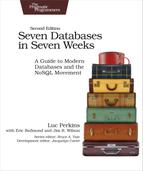Chapter
4
MongoDB
MongoDB is in many ways like a power drill. Your ability to complete a task is framed largely by the components you choose to use (from drill bits of varying size to sander adapters). MongoDB’s strength lies in its versatility, power, ease of use, and ability to handle jobs both large and small. Although it’s a much newer invention than the hammer, it is a tool that builders reach for more and more often.
First publicly released in 2009, MongoDB (often just called Mongo) quickly became one of the most widely used NoSQL databases in existence, and remains somewhere very close to the top—if not right at the top—of that list today. MongoDB was designed as a scalable database—the name Mongo comes from “humongous”—with performance and easy data access as core design goals. It is a document database, which allows you to store objects nested to whichever depth you’d like, and you can query that nested data in an ad hoc fashion. It enforces no schema (similar to HBase but unlike Postgres), so documents can contain fields or types that no other document in the collection contains (whether that’s advisable is another matter).
But don’t think that MongoDB’s flexibility makes it a toy. There are some huge production MongoDB deployments out there, such as Foursquare, Comcast, Adobe, and CERN, where it’s used to collect data from the Large Hadron Collider.
